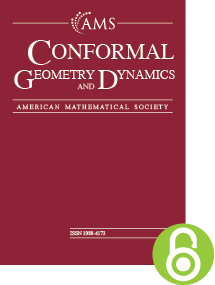Constructing rational maps from subdivision rules
HTML articles powered by AMS MathViewer
- by J. W. Cannon, W. J. Floyd, R. Kenyon and W. R. Parry
- Conform. Geom. Dyn. 7 (2003), 76-102
- DOI: https://doi.org/10.1090/S1088-4173-03-00082-1
- Published electronically: July 28, 2003
- PDF | Request permission
Abstract:
Suppose $\mathcal {R}$ is an orientation-preserving finite subdivision rule with an edge pairing. Then the subdivision map $\sigma _{\mathcal {R}}$ is either a homeomorphism, a covering of a torus, or a critically finite branched covering of a 2-sphere. If $\mathcal {R}$ has mesh approaching $0$ and $S_{\mathcal {R}}$ is a 2-sphere, it is proved in Theorem 3.1 that if $\mathcal {R}$ is conformal, then $\sigma _{\mathcal {R}}$ is realizable by a rational map. Furthermore, a general construction is given which, starting with a one-tile rotationally invariant finite subdivision rule, produces a finite subdivision rule $\mathcal {Q}$ with an edge pairing such that $\sigma _{\mathcal {Q}}$ is realizable by a rational map.References
- Philip L. Bowers and Kenneth Stephenson, A “regular” pentagonal tiling of the plane, Conform. Geom. Dyn. 1 (1997), 58–68. MR 1479069, DOI 10.1090/S1088-4173-97-00014-3
- Eva Brezin, Rosemary Byrne, Joshua Levy, Kevin Pilgrim, and Kelly Plummer, A census of rational maps, Conform. Geom. Dyn. 4 (2000), 35–74. MR 1749249, DOI 10.1090/S1088-4173-00-00050-3
- Hans Brolin, Invariant sets under iteration of rational functions, Ark. Mat. 6 (1965), 103–144 (1965). MR 194595, DOI 10.1007/BF02591353
- James W. Cannon, The combinatorial Riemann mapping theorem, Acta Math. 173 (1994), no. 2, 155–234. MR 1301392, DOI 10.1007/BF02398434
- J. W. Cannon and E. L. Swenson, Recognizing constant curvature discrete groups in dimension $3$, Trans. Amer. Math. Soc. 350 (1998), no. 2, 809–849. MR 1458317, DOI 10.1090/S0002-9947-98-02107-2
- J. W. Cannon, W. J. Floyd, and W. R. Parry, Squaring rectangles: the finite Riemann mapping theorem, The mathematical legacy of Wilhelm Magnus: groups, geometry and special functions (Brooklyn, NY, 1992) Contemp. Math., vol. 169, Amer. Math. Soc., Providence, RI, 1994, pp. 133–212. MR 1292901, DOI 10.1090/conm/169/01656
- J. W. Cannon, W. J. Floyd, and W. R. Parry, Sufficiently rich families of planar rings, Ann. Acad. Sci. Fenn. Math. 24 (1999), no. 2, 265–304. MR 1724092
- J. W. Cannon, W. J. Floyd, and W. R. Parry, Finite subdivision rules, Conform. Geom. Dyn. 5 (2001), 153–196. MR 1875951, DOI 10.1090/S1088-4173-01-00055-8 Expi J. W. Cannon, W. J. Floyd, and W. R. Parry, Expansion complexes for finite subdivision rules I, preprint. Expii J. W. Cannon, W. J. Floyd, and W. R. Parry, Expansion complexes for finite subdivision rules II, in preparation.
- Adrien Douady and John H. Hubbard, A proof of Thurston’s topological characterization of rational functions, Acta Math. 171 (1993), no. 2, 263–297. MR 1251582, DOI 10.1007/BF02392534 Fo L. R. Ford, Automorphic Functions, Mc-Graw Hill, New York, 1929.
- Tapani Kuusalo, Verallgemeinerter Riemannscher Abbidungssatz und quasikonforme Mannigfaltigkeiten, Ann. Acad. Sci. Fenn. Ser. A I 409 (1967), 24 (German). MR 0218560 La S. Lattès, Sur l’iteration des substitutions rationelles et les fonctions de Poincaré, C. R. Acad. Sci. Paris 16 (1918), 26–28.
- Joseph Lehner, Discontinuous groups and automorphic functions, Mathematical Surveys, No. VIII, American Mathematical Society, Providence, R.I., 1964. MR 0164033, DOI 10.1090/surv/008
- Curtis T. McMullen, Complex dynamics and renormalization, Annals of Mathematics Studies, vol. 135, Princeton University Press, Princeton, NJ, 1994. MR 1312365
- Daniel Meyer, Quasisymmetric embedding of self similar surfaces and origami with rational maps, Ann. Acad. Sci. Fenn. Math. 27 (2002), no. 2, 461–484. MR 1922201
- John Milnor, Dynamics in one complex variable, Friedr. Vieweg & Sohn, Braunschweig, 1999. Introductory lectures. MR 1721240 Pi1 K. M. Pilgrim, Cylinders for iterated rational maps, Ph.D. thesis, University of California, Berkeley, 1994.
- Kevin M. Pilgrim, Canonical Thurston obstructions, Adv. Math. 158 (2001), no. 2, 154–168. MR 1822682, DOI 10.1006/aima.2000.1971 CP K. Stephenson, CirclePack, software, available from http://www.math.utk.edu/˜kens.
- Edwin H. Spanier, Algebraic topology, McGraw-Hill Book Co., New York-Toronto-London, 1966. MR 0210112
- Dennis Sullivan, Quasiconformal homeomorphisms and dynamics. I. Solution of the Fatou-Julia problem on wandering domains, Ann. of Math. (2) 122 (1985), no. 3, 401–418. MR 819553, DOI 10.2307/1971308
- Dennis Sullivan, Conformal dynamical systems, Geometric dynamics (Rio de Janeiro, 1981) Lecture Notes in Math., vol. 1007, Springer, Berlin, 1983, pp. 725–752. MR 730296, DOI 10.1007/BFb0061443 Th W. P. Thurston, Lecture notes, CBMS Conference, University of Minnesota at Duluth, 1983.
Bibliographic Information
- J. W. Cannon
- Affiliation: Department of Mathematics, Brigham Young University, Provo, Utah 84602
- Email: cannon@math.byu.edu
- W. J. Floyd
- Affiliation: Department of Mathematics, Virginia Tech, Blacksburg, Virginia 24061
- MR Author ID: 67750
- Email: floyd@math.vt.edu
- R. Kenyon
- Affiliation: Laboratoire de Topologie, Université Paris-Sud, Bat. 425, 91405 Orsay Cedex-France
- MR Author ID: 307971
- W. R. Parry
- Affiliation: Department of Mathematics, Eastern Michigan University, Ypsilanti, Michigan 48197
- MR Author ID: 136390
- Email: walter.parry@emich.edu
- Received by editor(s): September 5, 2001
- Received by editor(s) in revised form: April 4, 2003
- Published electronically: July 28, 2003
- Additional Notes: This research was supported in part by NSF grants DMS-9803868, DMS-9971783, and DMS-10104030.
- © Copyright 2003 American Mathematical Society
- Journal: Conform. Geom. Dyn. 7 (2003), 76-102
- MSC (2000): Primary 37F10, 52C20; Secondary 57M12
- DOI: https://doi.org/10.1090/S1088-4173-03-00082-1
- MathSciNet review: 1992038


